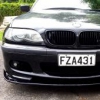Leaderboard
Popular Content
Showing content with the highest reputation on 11/03/17 in all areas
-
2 pointsMans progress always comes at a cost and nothing is perfect. It's also more convenient for some to make money out of imperfect solutions.
-
2 pointsCould you look at a bigger alternator - I know some beemers had some pretty grunty ones? Also could you change all your lights to led to lower the load when driving on a cold night?
-
2 pointsYep the valet lock is a mechanical deadlock. I managed to get into the boot, but had to use a 5mm drill bit behind the number plate and engage the locking mechanism that holds the boot down. I used a hammer to loosen the actual deadlock so that the key finally turned back to vertical position - but the cylinder needs replacing. Will need to get the hole filled up too - maybe with some 'Knead It' or any other better alternatives (I'll chat to a panelbeater). Going to buy some spares from Brent (cylinder + actuator) and the locksmith said he will recalibrate the cylinder to work with my key. Knowing my luck, about an hour after I got the boot open, my driver door lock cylinder broke too, which now does not turn left (So I can't lock it using the key). So looks like I'll need to buy a cylinder for the driver door too now. Oh the joy. Also doesn't help that my driver door actuator is dead (has been since i got the car) so can't just electronically lock it. As a temporary solution I am using hacky means of locking the car: Get inside car, open driver side window, use central locking to lock all other doors, keep key in ignition in power mode, get out of car, physically press the lock down on driver door through the open window, press the electronic window close button, pull key out of ignition before window closes... Not fun. Hopefully sort it out in the next week or so. Locksmith said he's worked on some of these BMW locks before and they are a pain in the ass. So if any of your locks/keys have trouble turning, I'd consider getting a replacement soon, because once it's broken it's hard to get into!
-
2 pointsCan you stop arguing on every single thread? People wont want to post projects if they know they will be attacked.
-
1 point
-
1 pointNup only drivers door. Both doors seemed to stop at E36. E39 locks are a prick to pick too. I haven't even managed to on my car. Irony is though - i can pick the later car locks relatively easily too
-
1 pointHere's the original 'Sealing Frame' gasket from between the heater box and firewall. This was the bottom left corner which happens to be where the leak was. It's pretty clear the seal has either failed or was never installed correctly from the factory. On the new install the seal has been checked and the sealing foam can be seen bulging out from the inside and from the engine bay so it looks like it has a good seal this time. Another give-away was when the old heater was removed it didn't take much of a push to get it free. On the donor heater I got from the wreckers a jimmy-bar was needed to pry it loose - it was stuck pretty good.
-
1 pointHere's a couple of shots of the heater fitted in-car. The two red wires in a loop need an in-line fuse fitted as they're direct wired to the battery, currently with no protection. Ok for testing but not running live. Once fuses are fitted they'll be tied near the back of the loom and accessible when the kick panel below the glovebox is removed. The side of the glovebox clears the tallest parts on the PCB by about 5mm. It all just squeezes in where the old water pipes used to go.
-
1 pointAgree, but look at how much land per mw hydro uses, and compare that to solar and wind. For example Benmore puts out 540mw. The largest windfarm in Europe peaks at 600mw and covers 110 square kilometres. And that is just peak - because wind is not reliable or consistent they expect only 30% of that 600mw capacity - so only 180mw. They would need to be triple the size just to match Benmore.
-
1 pointI already have a 140A alternator which is the biggest one available as a standard part for the E36. To go bigger might require a custom fit. The electric elements should use about 60A which is well within the 140A rating of the alternator. What I can't find out is if the 140A rating is continuous or short-term for peak loads with a somewhat lower continuous rating. With the heater running + headlights on high-beam + heater fan + other minor loads there could be close to 100A required. Knowing the continuous rating of the alternator would help give some certainty it will be ok or could fail. LED lights is a good option as long as they have the gadget to trick the blown bulb detection circuit. Hadn't thought of this as an option to lower power use...
-
1 pointHere's a wrap-up of what I learned during the software testing and then in-car hardware testing. The PCB worked perfectly first time so no issues. The power supply was originally going to come from the heater solenoid +12V but this line is always live even with the ignition switched off. The power on this line also gets switched off when the drivers-side temperature selector is wound to maximum. The next issue which was minor was the logic levels for the solenoid on/off control were inverted. I'd assumed they were pulled low to activate the solenoid to let water flow into the heater core. However, the heater solenoid valves are always open and close when the solenoid is activated. This means the solenoid drive signals go low to turn off the heater instead of on. This was an easy fix - the advantage of doing all the control in software, the input on-state level was inverted. I ended up taking the 12V supply for the new PCB from the heater fan switch. The easiest access to this was on the resistor block that plugs into the back of the heater box. There's 4 wires for the 1,2,3,4 values on the heater fan speed selector switch. I added a diode from each wire to a common point so no matter what the switch setting was there's always 12V. Now the heater controls only come on with the fan switch and car ignition also has to be on first. If the engine isn't running the main power relays don't pull in because the battery voltage is too low. At idle only one heater can be used as the battery voltage sags too much due to the alternator not producing enough output at low RPM. From 1500RPM both can be run. You can certainly hear the alternator loading up though - will have to see if it toughs it out. Usually the heater will only get used if it's cold so the alternator will also get colder cooling air so hopefully it won't be a problem. I couldn't find much information about the alternator and what it's continuous rating is. If the voltage gets too low the FET's switch off and the relays open. There's then a 15 second time delay before the relays are allowed to close again and FET's turn back on. This is to stop rapid cycling of the relays. I did some more tests today to see how much heat is generated. With the fan on 3 there was a noticeable difference in the air temperature coming from the vents. It might be better than previously stated. The real test will be how long it takes to warm up the cabin in winter.
-
1 pointDoes my 15s start now? *Ahem* "Thank you very much. I'll be here all week" [/drop mike]
-
1 point
-
1 point
-
1 point








